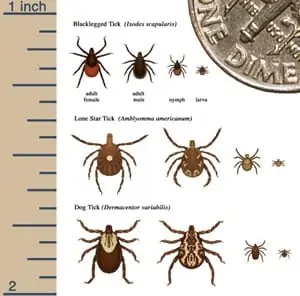Summer is on its way! With the warm weather and vacation opportunities, it is important to stay aware of the increased health risks that warmer weather can bring. Of the many things we can encounter while spending hot afternoons outside, I would like to touch on one in particular – Lyme Disease. There isn’t a whole lot of discussion on the disease which makes many people unaware of its seriousness. However, my husband suffered with it for years, and after watching him lose his early twenties to this unfortunate disease, I want to make sure I help inform others of its dangers.
The disease is named after Lyme, Connecticut where numerous children were being diagnosed with rheumatoid arthritis. After a mother of one of the children began demanding more research be done, the bacteria that causes Lyme was discovered as the common denominator between all the children, and Lyme Disease was revealed.
The disease is transmitted by infected black-legged ticks and can cause serious health problems if left untreated. Without proper diagnosis and treatment, it can affect joints, the heart, and the nervous system. My husband went two and a half years without a diagnosis, and he had constant headaches and joint pain. He developed sensitivity to alcohol, blurred vision, and crushing fatigue. Lyme disease is not something that is routinely tested for so none of the doctors we visited thought to test him for it.
When we finally realized his symptoms coincided with the disease, we asked his physician to test him, and he flat out told us it was unnecessary. Needless to say, we went to a different physician and had the test done. The testing can be very complicated and depending on how long the disease is in your system it might not show a positive result right away. It is most often diagnosed by symptoms, but if used correctly, lab work can help confirm the diagnosis.
If you spend a lot of time outdoors, especially in wooded areas, make sure to protect yourself, your kids, and your pets from potential tick bites.
Tips for Preventing Lyme Disease
- Wear bug spray while spending time in wooded areas
- Thoroughly check for ticks after being in an area where ticks may be present. Shower if you can and make sure to check in hair and behind ears. They like to hide.
- Check pets for ticks and continue to do so for a few days. It can be difficult to see ticks because of the animal’s fur, but after a tick has burrowed itself into the skin it will get bigger after feeding on its host so you may be more apt to find it a few days later.
- If you find a tick burrowed into the skin or the fur of your pet, use tweezers to gently but firmly pull it free. It will need to be grasped as close to the skin as possible in order to pull out the whole tick without leaving behind pieces of its head or mouth buried in the skin.
- The CDC doesn’t recommend using heat; however, every time I have had to remove a tick, this has worked best. We used a heated needle to injure the tick forcing it to release its grip. I heat a needle and place the hot metal against the head of the tick being careful to only touch the tick. It should force it to release and you can use tweezers to remove the entire tick. They hold on with incredible force so if the head gets stuck in the skin be sure to use tweezers to pull it out all the way.
- Keep the tick once it is removed. Put it in a Ziploc bag. If you start to exhibit symptoms of Lyme Disease you can have the tick tested to see if it was a carrier.
- Stay diligent for symptoms. If infected with Lyme Disease you will start to exhibit flu-like symptoms such as headache, fatigue, and nausea, within two weeks, and you may even develop a rash at the site of the tick bite.
- Immediately go to the doctor and let them know your concerns. Most exposure to Lyme Disease can be treated with antibiotics if caught soon enough.
For more information please visit the CDC Website and stay tick free this summer.


